Page 245 of 769
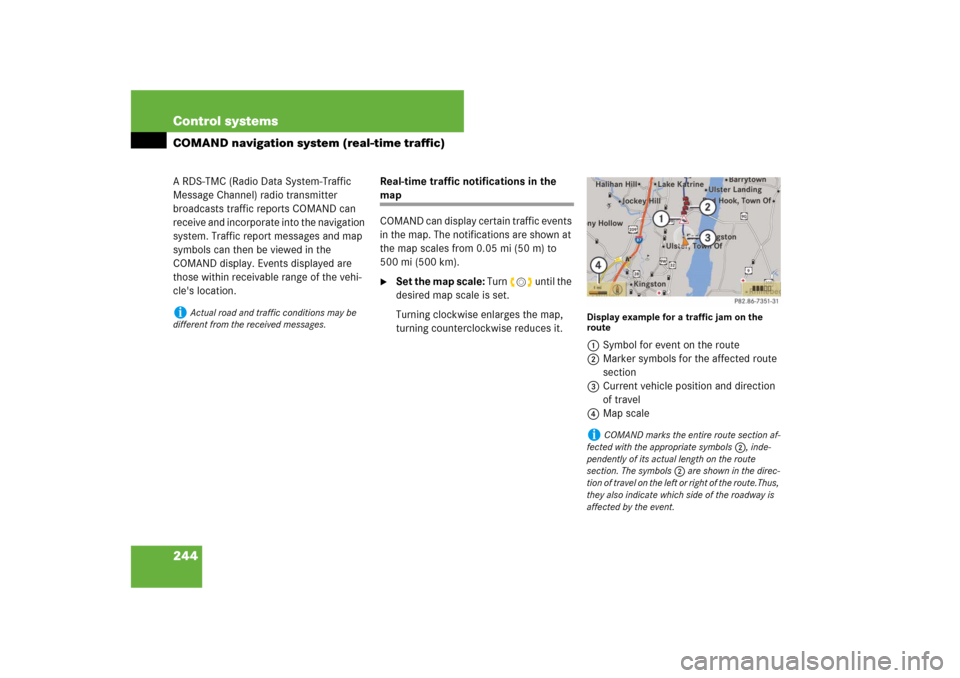
244 Control systemsCOMAND navigation system (real-time traffic)A RDS-TMC (Radio Data System-Traffic
Message Channel) radio transmitter
broadcasts traffic reports COMAND can
receive and incorporate into the navigation
system. Traffic report messages and map
symbols can then be viewed in the
COMAND display. Events displayed are
those within receivable range of the vehi-
cle's location.Real-time traffic notifications in the
map
COMAND can display certain traffic events
in the map. The notifications are shown at
the map scales from 0.05 mi (50 m) to
500 mi (500 km).�
Set the map scale: Turn ymz until the
desired map scale is set.
Turning clockwise enlarges the map,
turning counterclockwise reduces it.
Display example for a traffic jam on the
route1Symbol for event on the route
2Marker symbols for the affected route
section
3Current vehicle position and direction
of travel
4Map scale
i
Actual road and traffic conditions may be
different from the received messages.
i
COMAND marks the entire route section af-
fected with the appropriate symbols2, inde-
pendently of its actual length on the route
section. The symbols2 are shown in the direc-
tion of travel on the left or right of the route.Thus,
they also indicate which side of the roadway is
affected by the event.
Page 246 of 769
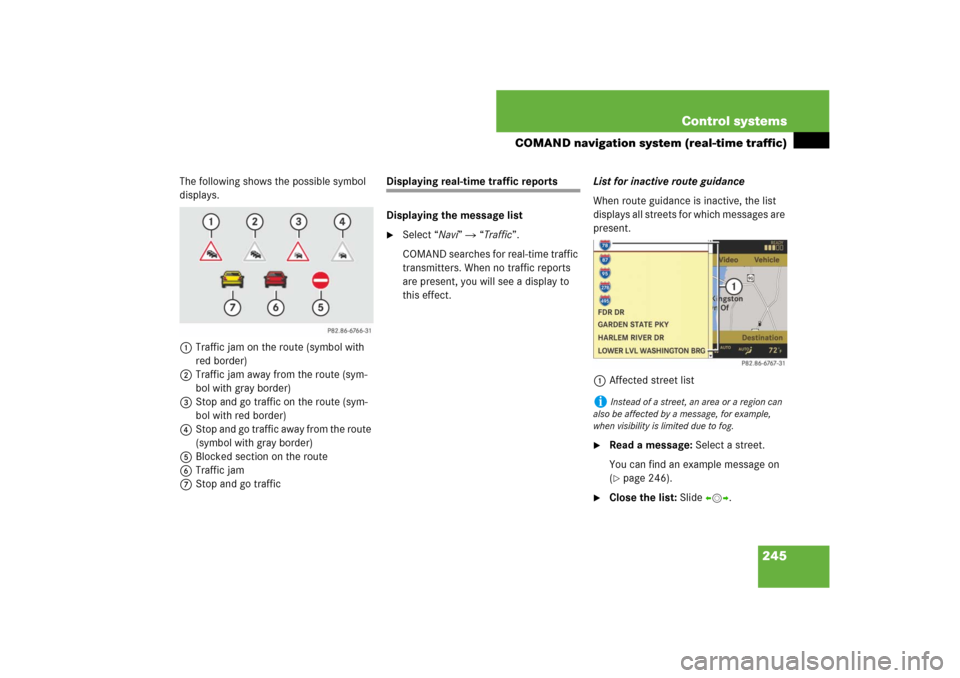
245 Control systems
COMAND navigation system (real-time traffic)
The following shows the possible symbol
displays.
1Traffic jam on the route (symbol with
red border)
2Traffic jam away from the route (sym-
bol with gray border)
3Stop and go traffic on the route (sym-
bol with red border)
4Stop and go traffic away from the route
(symbol with gray border)
5Blocked section on the route
6Traffic jam
7Stop and go traffic
Displaying real-time traffic reports
Displaying the message list�
Select “Navi” � “Traffic”.
COMAND searches for real-time traffic
transmitters. When no traffic reports
are present, you will see a display to
this effect.List for inactive route guidance
When route guidance is inactive, the list
displays all streets for which messages are
present.
1Affected street list
�
Read a message: Select a street.
You can find an example message on
(�page 246).
�
Close the list: Slide omp.
i
Instead of a street, an area or a region can
also be affected by a message, for example,
when visibility is limited due to fog.
Page 247 of 769
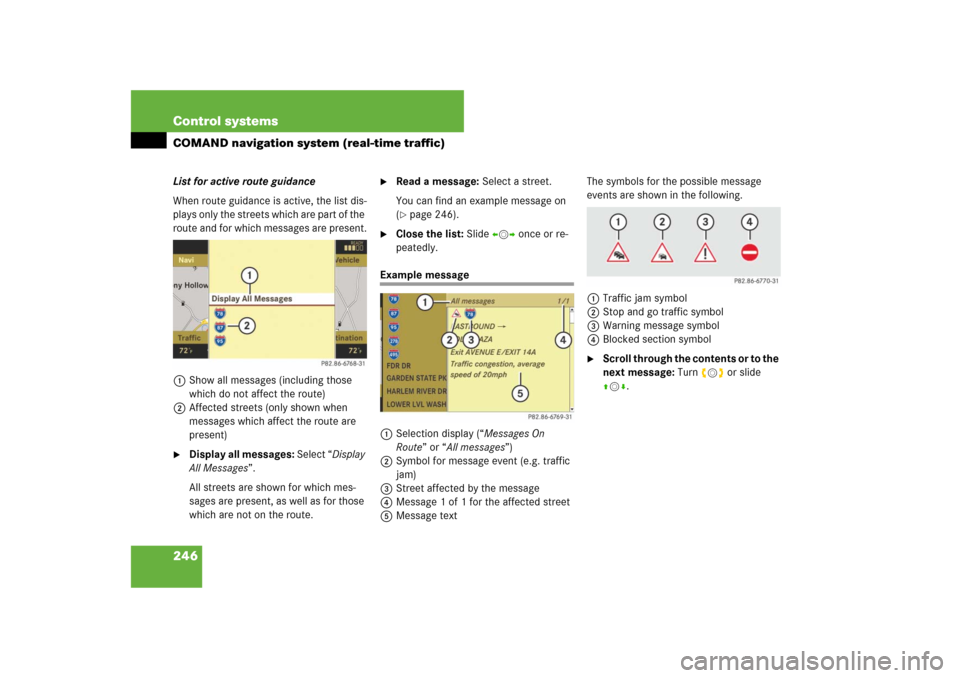
246 Control systemsCOMAND navigation system (real-time traffic)List for active route guidance
When route guidance is active, the list dis-
plays only the streets which are part of the
route and for which messages are present.
1Show all messages (including those
which do not affect the route)
2Affected streets (only shown when
messages which affect the route are
present)�
Display all messages: Select “Display
All Messages”.
All streets are shown for which mes-
sages are present, as well as for those
which are not on the route.
�
Read a message: Select a street.
You can find an example message on
(�page 246).
�
Close the list: Slide omp once or re-
peatedly.
Example message
1Selection display (“Messages On
Route” or “All messages”)
2Symbol for message event (e.g. traffic
jam)
3Street affected by the message
4Message 1 of 1 for the affected street
5Message textThe symbols for the possible message
events are shown in the following.
1Traffic jam symbol
2Stop and go traffic symbol
3Warning message symbol
4Blocked section symbol
�
Scroll through the contents or to the
next message: Turn ymz or slide
qmr.
Page 248 of 769
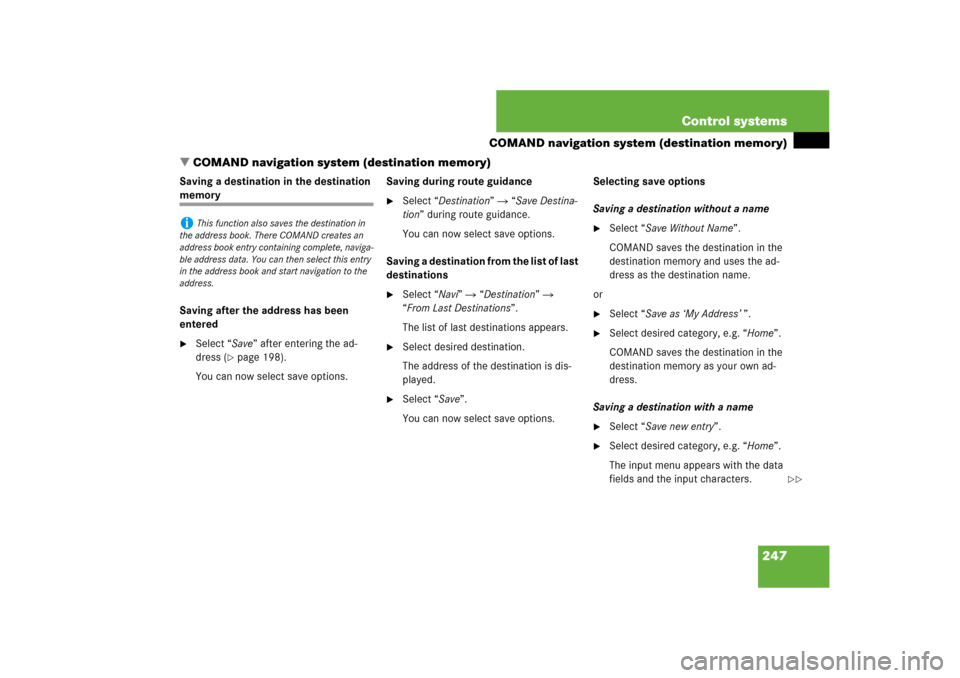
247 Control systems
COMAND navigation system (destination memory)
�COMAND navigation system (destination memory)
Saving a destination in the destination memory
Saving after the address has been
entered�
Select “Save” after entering the ad-
dress (
�page 198).
You can now select save options.Saving during route guidance
�
Select “Destination” � “Save Destina-
tion” during route guidance.
You can now select save options.
Saving a destination from the list of last
destinations
�
Select “Navi” � “Destination” �
“From Last Destinations”.
The list of last destinations appears.
�
Select desired destination.
The address of the destination is dis-
played.
�
Select “Save”.
You can now select save options.Selecting save options
Saving a destination without a name
�
Select “Save Without Name”.
COMAND saves the destination in the
destination memory and uses the ad-
dress as the destination name.
or
�
Select “Save as ‘My Address’ ”.
�
Select desired category, e.g. “Home”.
COMAND saves the destination in the
destination memory as your own ad-
dress.
Saving a destination with a name
�
Select “Save new entry”.
�
Select desired category, e.g. “Home”.
The input menu appears with the data
fields and the input characters.
i
This function also saves the destination in
the address book. There COMAND creates an
address book entry containing complete, naviga-
ble address data. You can then select this entry
in the address book and start navigation to the
address.
��
Page 249 of 769
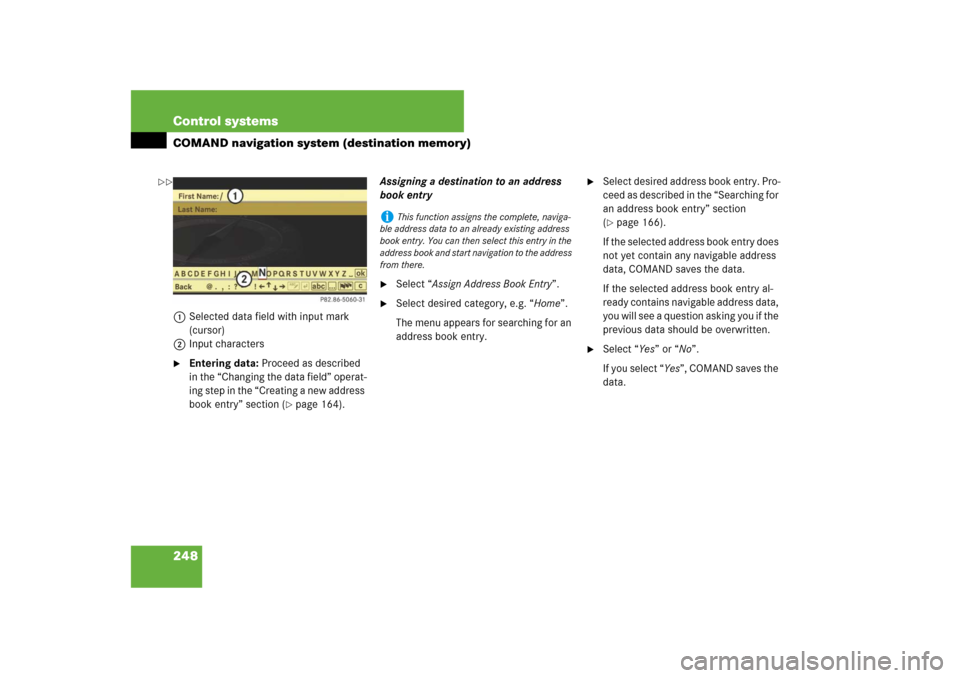
248 Control systemsCOMAND navigation system (destination memory)1Selected data field with input mark
(cursor)
2Input characters�
Entering data: Proceed as described
in the “Changing the data field” operat-
ing step in the “Creating a new address
book entry” section (
�page 164).Assigning a destination to an address
book entry
�
Select “Assign Address Book Entry”.
�
Select desired category, e.g. “Home”.
The menu appears for searching for an
address book entry.
�
Select desired address book entry. Pro-
ceed as described in the “Searching for
an address book entry” section
(�page 166).
If the selected address book entry does
not yet contain any navigable address
data, COMAND saves the data.
If the selected address book entry al-
ready contains navigable address data,
you will see a question asking you if the
previous data should be overwritten.
�
Select “Yes” or “No”.
If you select “Yes”, COMAND saves the
data.
i
This function assigns the complete, naviga-
ble address data to an already existing address
book entry. You can then select this entry in the
address book and start navigation to the address
from there.
��
Page 250 of 769
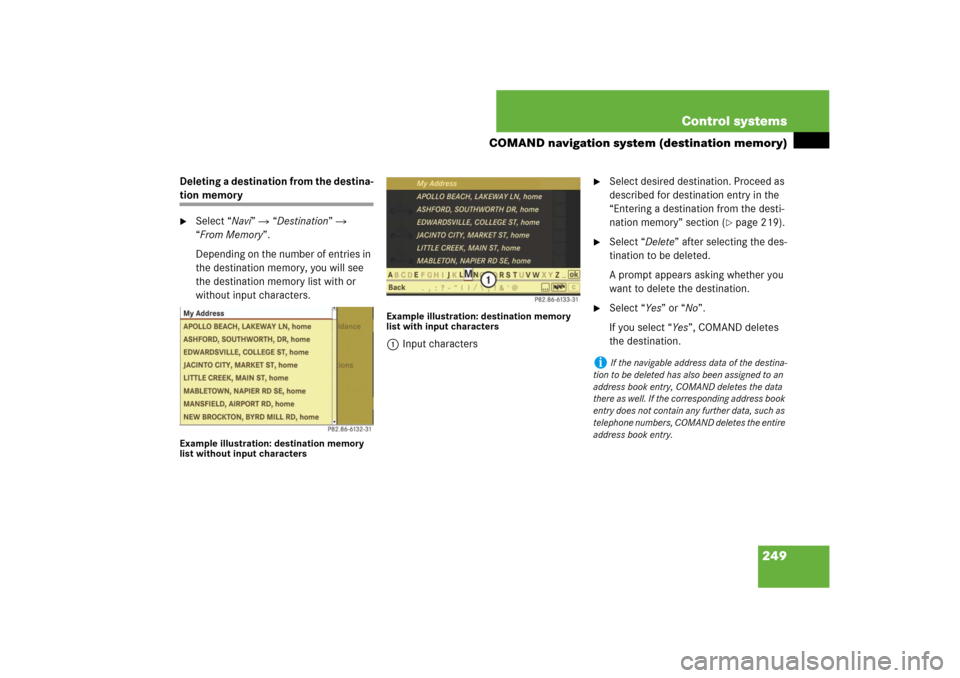
249 Control systems
COMAND navigation system (destination memory)
Deleting a destination from the destina-tion memory�
Select “Navi” � “Destination” �
“From Memory”.
Depending on the number of entries in
the destination memory, you will see
the destination memory list with or
without input characters.
Example illustration: destination memory
list without input charactersExample illustration: destination memory
list with input characters
1Input characters
�
Select desired destination. Proceed as
described for destination entry in the
“Entering a destination from the desti-
nation memory” section (
�page 219).
�
Select “Delete” after selecting the des-
tination to be deleted.
A prompt appears asking whether you
want to delete the destination.
�
Select “Yes” or “No”.
If you select “Yes”, COMAND deletes
the destination.
i
If the navigable address data of the destina-
tion to be deleted has also been assigned to an
address book entry, COMAND deletes the data
there as well. If the corresponding address book
entry does not contain any further data, such as
telephone numbers, COMAND deletes the entire
address book entry.
Page 251 of 769
250 Control systemsCOMAND navigation system (destination memory)Own address
Assigning your address for the first
time or changing your own address
Assigning and/or changing your own
address�
Select “Navi” � “Destination” �
“From Memory”.
Depending on the number of entries in
the destination memory, you will see
the destination memory list with or
without input characters.
Example illustration: destination memory
list without input charactersIn the destination memory list without in-
put characters, the “My Address” entry is
automatically highlighted.
Example illustration: destination memory
list with input characters1Input characters
In the destination memory list with input
characters 1, the input characters are au-
tomatically activated.
i
The destination memory always contains an
entry called “My Address”. You can save your
home address, for example, under this entry.
Page 252 of 769
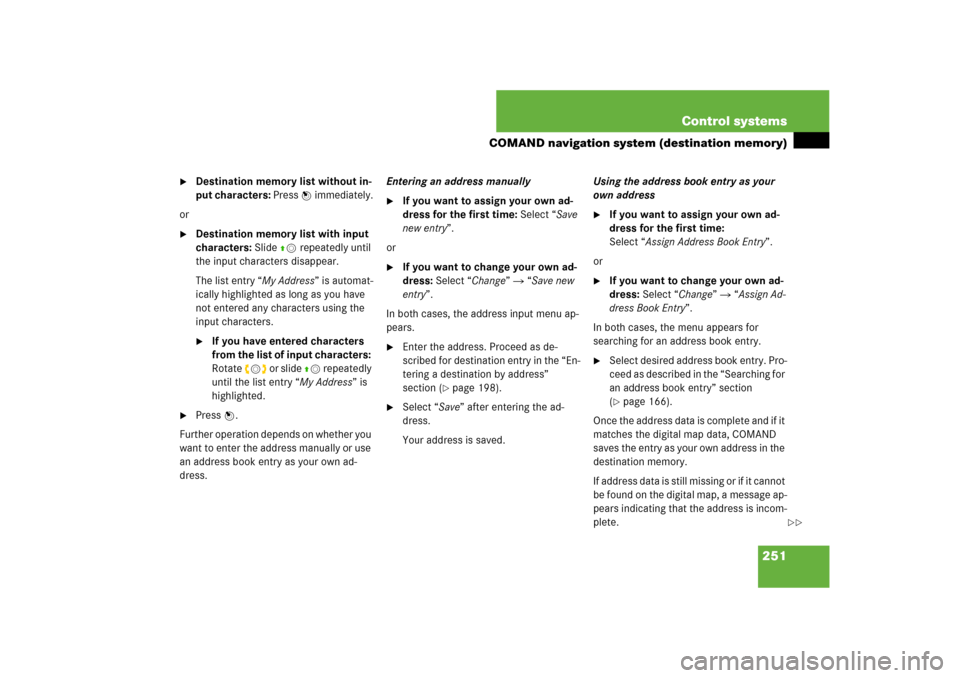
251 Control systems
COMAND navigation system (destination memory)
�
Destination memory list without in-
put characters: Press n immediately.
or
�
Destination memory list with input
characters: Slide qm repeatedly until
the input characters disappear.
The list entry “My Address” is automat-
ically highlighted as long as you have
not entered any characters using the
input characters.�
If you have entered characters
from the list of input characters:
Rotate ymz or slide qm repeatedly
until the list entry “My Address” is
highlighted.
�
Press n.
Further operation depends on whether you
want to enter the address manually or use
an address book entry as your own ad-
dress.Entering an address manually
�
If you want to assign your own ad-
dress for the first time: Select “Save
new entry”.
or
�
If you want to change your own ad-
dress: Select “Change” � “Save new
entry”.
In both cases, the address input menu ap-
pears.
�
Enter the address. Proceed as de-
scribed for destination entry in the “En-
tering a destination by address”
section (
�page 198).
�
Select “Save” after entering the ad-
dress.
Your address is saved.Using the address book entry as your
own address
�
If you want to assign your own ad-
dress for the first time:
Select “Assign Address Book Entry”.
or
�
If you want to change your own ad-
dress: Select “Change” � “Assign Ad-
dress Book Entry”.
In both cases, the menu appears for
searching for an address book entry.
�
Select desired address book entry. Pro-
ceed as described in the “Searching for
an address book entry” section
(�page 166).
Once the address data is complete and if it
matches the digital map data, COMAND
saves the entry as your own address in the
destination memory.
If address data is still missing or if it cannot
be found on the digital map, a message ap-
pears indicating that the address is incom-
plete.
��